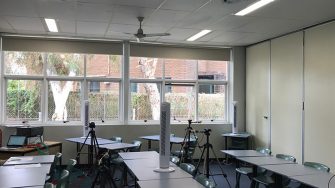
This study was performed to propose, implement, monitor and evaluate the performance of proper advanced hybrid ventilation technologies able to improve indoor air quality, achieve thermal comfort conditions and at the same time reduce energy consumption and carbon emissions. It has been shown that the new ventilation system and Healthbox result in improved ventilation and air quality in the investigated school classroom.
Project Aim (and/or Objectives)
Schools present important energy and environmental problems. There is much concern about indoor thermal comfort conditions in school buildings as research has demonstrated that it affects the health, learning and performance of students and staff. Moreover, thermal comfort conditions in schools are of particular importance, as children spend almost one-third of their day (12 per cent of their time) inside classrooms. Also, children are less resistant to adverse environmental conditions compared with adults.
Overheating of urban areas caused by the combined effects of global climate change and the urban heat island phenomenon is leading to increased thermal discomfort in schools. The widespread and growing use of air conditioning systems as a solution to maintain a comfortable indoor environment results in increased energy consumption for cooling and carbon emissions and exacerbates the energy bills of schools. Providing good indoor thermal comfort conditions in school buildings that enhance the wellbeing and learning performance of students while maintaining a low energy consumption and carbon footprint is an obvious necessity.
This study was performed to propose, implement, monitor, and evaluate the performance of proper advanced hybrid ventilation technologies able to improve indoor air quality, achieve thermal comfort conditions and at the same time reduce energy consumption and carbon emissions. It has been shown that the new ventilation system results in improved ventilation and air quality in the investigated school classroom.
The main objective of the study is:
To investigates hybrid solutions using enhanced ventilation to achieve indoor comfort conditions and at the same time reduce energy consumption and carbon emissions and then test it in the selected school building located in Sydney, which co-funded this project.
Project Outcomes
- Analysis of indoor air quality and thermal comfort shows significant improvements in reducing CO2 and VOCs in classroom with ventilation compared to the classroom without ventilation. This will ultimately help reduce adverse health impacts of the environmental condition on children and improve productivity and performance.
- Australian students feel comfortable at a mean comfort temperature of 23.4 °C. This is consistent with previous literature and highlights that children feel comfortable in slightly lower thermal environments compared to adults.
Method
- Assessment of the thermal comfort conditions and air quality over one year (2018-2019).
- Investigation of passive/ hybrid solutions for improving thermal comfort conditions of school classrooms.
- Installation and evaluation of a hybrid ventilation system to improve thermal comfort and air quality.
Project participants
Project leader: Scientia Prof. Mattheos Santamouris
Research team: Dr Shamila Haddad, Dr Riccardo Paolini
Contact person
Prof. Mattheos Santamouris, m.santamouris@unsw.edu.au
Links
Hybrid ventilation systems for schools
In media:
1. Classrooms lack ventilation and students are paying the price
2. Poor air quality in classrooms detrimental to kids' wellbeing and learning
3. Australian schools failing on indoor air quality
https://www.hvacrnews.com.au/news/australian-schools-failing-on-indoor-air-quality/
4. Schools need ventilation for better health and student learning, not air-conditioning
